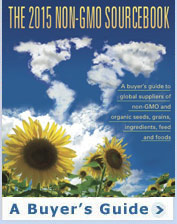Breeding efforts aim to save non-GMO and organic corn seed
Increasing acreage of genetically modified corn, greater GMO contamination risks, and fewer seed companies developing non-GMO corn varieties are combining to threaten the future of non-GMO and organic corn seed. But corn breeders are developing corn hybrids with traits to preserve and enhance organic and non-GMO production. (This is the first of a 2-part series.)
Mary Eubanks’ decision to breed non-GMO and organic corn hybrids was not based on ideology. It was her health. A few years ago, she worked with genetically modified Bt corn, but found she was allergic to it. “Exposure to GM corn pollen makes my eyes itchy, watery and swollen, and I break out in a rash,” she says. “If I am allergic to it, it could be bad for other people as well.”
Rich, new genetic diversity for corn
Eubanks is adjunct professor of biology at Duke University and founder of Sun Dance Genetics LLC, a company that is developing drought- and disease-resistant corn varieties for non-GMO and organic production.
Using conventional plant breeding, Eubanks has developed a “genetic bridge” between corn and gamagrass, a wild North American grass that contains hardy genes adapted to a wide variety of environments. She successfully transferred beneficial traits from gamagrass, such as drought tolerance, higher protein levels, and insect and disease resistance, to corn. Initial field tests are promising. “This breakthrough provides rich, new genetic diversity for corn improvement,” says Eubanks.
Reducing nitrogen applications
One promising aspect of Eubanks’ work is her effort to reduce the amount of nitrogen fertilizer needed to grow corn. “We want to develop hybrid corn that will give high yields with lower nitrogen inputs,” she says.
Conventional and GM corn production requires large amounts of nitrogen fertilizer, about 140 pounds per acre. The problem is that nitrogen runs off farmland into streams, rivers, and other waterways. In the Midwest each year, nitrogen run off into the Mississippi River contributes to the massive “dead zone” in the Gulf of Mexico by reducing oxygen levels, which kills aquatic life. Excess nitrate in drinking water is also a threat to human health. “Nitrogen is a huge problem,” says Eubanks.
The Mississippi River Basin & Gulf of Mexico Hypoxia Task Force, a consortium of federal and state government agencies, has set a goal of reducing the amount of nitrogen going into the waterways by 30% by the year 2015.
Eubanks received funding from the National Science Foundation and the North Carolina Board of Science and Technology to develop corn hybrids that have high nitrogen use efficiency (NUE). Initial field tests found that her Sun Dance corn hybrids were 25% higher in NUE than conventional corn hybrids. In addition, the Sun Dance hybrids had higher yields
“Looking at the data, we believe that we will be able to develop hybrids that will reduce nitrogen applications by as much as 30% to 35%, which could help meet the Hypoxia Task Force’s goal,” says Eubanks. “This offers a practical solution to the environmental problems and health issues caused by the extremely high amounts of nitrogen fertilizer that are applied to corn.”
The reduced need for nitrogen fertilizer could appeal to conventional farmers who are seeing prices for synthetic nitrogen fertilizer soar with today’s high cost of oil. This year they will pay as much as $800 per ton.
Sun Dance hybrids are also higher in protein. “One inbred has 19% protein, which could be fantastic for the poultry industry,” says Eubanks.
Committed to non-GMO and organic production
Sun Dance corn hybrids won’t be ready for commercial release until 2010 at the earliest. “We will not release any commercial corn hybrids until we have at least two years of good, consistent field performance data,” she says. “A more realistic target for product launch is 3-5 years.”
The hybrids will be for non-GMO and organic production. “Our company is committed to non-GMO,” she says.
Organic is even better, says Eubanks. “Organic practices are healthier for everybody in every way. It is the way to go if you can.”
She believes non-GMO production zones are needed to preserve the genetic integrity of non-GMO and organic. “I do not see how we can ever have coexistence,” she says. “Insects are moving pollen all over. We need to maintain areas where GMOs are not grown.”
Sun Dance Genetics is working with several seed companies to develop the new hybrids. Blue River Hybrids, based in Kelly, Iowa, is planting field trials for organic production. Company president Maury Johnson says the Sun Dance hybrids are promising, but that “it will take some development work and testing before commercial hybrids are available.”
Eubanks admits that corn breeding is a time-consuming and complex process. Parent or “inbred” seed must be developed first, and two elite inbred lines are then combined to produce commodity hybrid seed.
“Loss of non-GMO seed is happening rapidly”
Time is of the essence because biotechnology companies, such as Monsanto, are buying foundation seed companies and non-GMO corn seed production is being phased out in favor of GMOs. “If all corn seed lines are converted to GM where will we get non-GM seed?” asks Eubanks.
Others echo her concerns. “The number of companies offering non-GM corn seed is shrinking, and it’s unknown how long untreated non-GM inbreds are going to be available from parent seed companies,” says Maynard Kropf of Prairie Hybrids, a non-GMO and organic corn seed company.
“There is more focus on GMO traits by breeding programs and less on (conventional) genetics,” says Mitch Jensen, genetic development manager, MBS Genetics, which provides non-GM corn foundation seed.
Eubanks feels a sense of urgency to establish her company as a foundation seed company for non-GMO and organic corn production. “The loss of non-GM seed is happening rapidly. We need to do this soon.”
© Copyright The Organic & Non-GMO Report April 2008.




